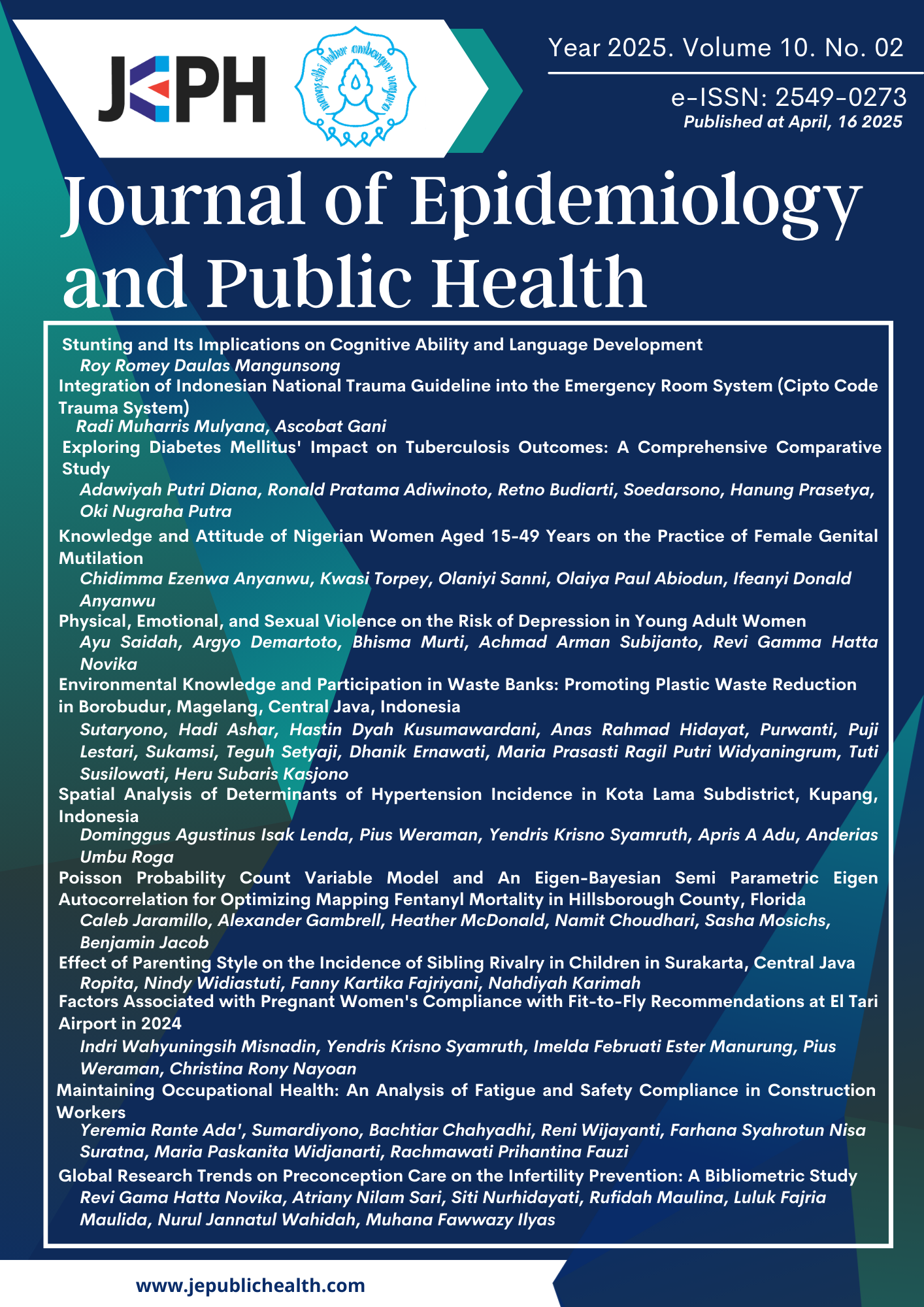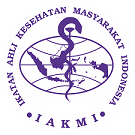Integration of Indonesian National Trauma Guideline into the Emergency Room System (Cipto Code Trauma System)
DOI:
https://doi.org/10.26911/jepublichealth.2025.10.02.02Abstract
Background: Indonesia has enacted the national trauma guideline since 2017 and Cipto Mangun-kusumo Hospital (CMH) has applied it since 2019 through the establishment of Cipto Code Trauma. This study aimed to describe the compliance, system adherence, performance and outcome associated with the Cipto Code Trauma system.
Subjects and Method: This cross-sectional study was conducted at CMH Emergency Room (ER) using direct observations and data from electronic health records (EHRs). Observations were performed on 106 trauma cases by convenience sampling to map clinical and non-clinical components using a checklist. We compared the implemented ER components against the 2017 national trauma guidelines, assessing the system compliance. Total sampling from EHRs was performed on 4,317 trauma patients to assess performance and outcome of Cipto Code Trauma system. The data were analyzed descriptively.
Results: Observations from 106 trauma cases indicate that the Cipto Code Trauma meets all criteria from the national trauma guidelines. Performance indicators from 840 patients were achieved, including trauma team activation (87.6%), on-site multidisciplinary consultation (87.6%), time to physician assessment within five minutes (84.4%), except for length of stay under 4 hours (18.5%) and time to operating theatre within two hours (45.5%). Among the 4,317 trauma cases, the mortality rate for patients in the resuscitation category was 0.4%, while 39% of these patients were discharged directly from the ER.
Conclusion: The Cipto Code Trauma at CMH has successfully integrated the Indonesian national trauma guidelines, meeting all required standards. However, further improvements are needed to enhance system adherence and performance.
Keywords:
adherence, emergency, guideline, trauma, performanceHow to Cite
References
Alharbi RJ, Shrestha S, Lewis V, Miller C (2021). The effectiveness of trauma care systems at different stages of de-velopment in reducing mortality: a systematic review and meta-analysis. World Journal of Emergency Surgery. 16(1): 38. doi:10.1186/s13017-021-00381-0.
Australian Government Department of Health and Ageing (2007). Emergency Triage Education Kit. Sydney, Department of Health and Ageing.
Baxter M, Crouch R, Bowyer R (2022). Adult Major Trauma Guidelines. Southampton, NHS Foundation Trust.
Bourgeois J, Clark G, Delaney S, Grushka J, Knopp-Sihota JA. (2024). Timing of Trauma Team Involvement and the Impact on the Length of Stay and Time to Definitive Care in the Emer-gency Department: A Retrospective Administrative Data and Chart Review. Canadian Journal of Emergency Nursing. 47(1): 30–37. doi:10.29173/cjen195.
Choi J, Carlos G, Nassar AK, Knowlton LM, Spain DA (2021). The impact of trauma systems on patient outcomes. Current Problems in Surgery. 58(1): 100849.doi:10.1016/j.cpsurg.2020.100849.
Emergency Health Services Branch Ministry of Health and Long Term Care. (2016). Prehospital Canadian Triage & Acuity Scale. Ontario, Ministry of Health.
Gauss T, de Jongh M, Maegele M, Cole E, Bouzat P (2024). Trauma systems in high socioeconomic index countries in 2050. Critical Care. 28(1): 84. doi:10.1186/s13054-024-04863-w.
Habib H, Sulistio S, Albar IA, Mulyana RM, Yundiarto N (2020). Validation of the Cipto Triage Method: A Single Centre Study from Indonesia. Open Access Emergency Medicine. Volume 12: 137–143. doi:10.2147/OAEM.S246598.
Hagebusch P, Faul P, Naujoks F, Klug A, Hoffmann R, Schweigkofler U (2022). Trauma team activation in Germany: how do emergency service professionals use the activation due to trauma mechanism? Results from a nationwide survey. European Journal of Trauma and Emergency Surgery. 48(1): 393–399. doi:10.1007/s00068-020-01425-x.
Kemenkes RI (2017). Keputusan Menteri Kesehatan Republik Indonesia Nomor HK.01.07/MENKES/132/2017 Tentang Pedoman Nasional Pelayanan Kedokteran Tatalaksana Trauma. Jakarta.
Kemenkes RI (2013). Riset Kesehatan Dasar (Riskesdas) 2013.
Kemenkes RI (2018). Riset Kesehatan Dasar (Riskesdas) DKI Jakarta 2018.
LaGrone L, Riggle K, Joshipura M, Quansah R, Reynolds T, Sherr K, Mock C. (2016). Uptake of the World Health Organization’s trauma care guidelines: a systematic review. Bulletin of the World Health Organization. 94(8): 585-598C. doi:10.2471/BLT.15.162214.
Mabrouk OEA, Osman FMA, Awad MSA. (2024). Knowledge, Attidue and Practice of Advanced Trauma Life Support (ATLS) Protocol among House Officers in Khartoum State Hospitals, Sudan, 2023. BMC Medical Education. 24(1): 670. doi:10.1186/s12909-024-05657-y.
Møller TP, Jensen JT, Medici RB, Rudolph SS, Andersen LB, Roed J, Blomberg SNF, et al., (2024). Survival of the fastest? A descriptive analysis of severely injured trauma patients primarily admitted or secondarily transferred to major trauma centers in a Danish inclusive trauma system. Scandinavian Journal of Trauma, Resuscitation and Emergency Medicine. 32(1): 87. doi:10.1186/s13049-024-01265-3.
Mulyana RM. (2022). 11th Asian Conference on Emergency Medicine (ACEM) 2021 Conference proceedings P057 Profiles and Outcomes of High Acuity Triage Trauma Patients in Emergency Department of a Tertiary Teaching Hospital in Jakarta, Indonesia. Hong Kong Journal of Emergency Medicine. 29(1). doi:10.1177/10249079221099636.
Ndayishimiye C, Tambor M, Dubas-Jakóbczyk K (2023). Barriers and Facilitators to Health-Care Provider Payment Reform – A Scoping Literature Review. Risk Management and Health-care Policy. Volume 16: 1755–1779. doi:10.2147/RMHP.S420529.
Plurad DS, Geesman G, Sheets NW, Chawla-Kondal B, Ayutyanont N, Mahmoud A. (2023). A Contemporary Analysis of the Effect of Trauma Center Verification Level on Mortality in Severe Injury. The American SurgeonTM. 89(2): 286–292. doi:10.1177/00031348211023437.
Reitano E, Bini R, Difino M, Chiara O, Cimbanassi S. (2022). Nine year in-hospital mortality trends in a high-flow level one trauma center in Italy. Updates in Surgery. 74(4): 1445–1451. doi:10.1007/s13304-022-01303-8.
Riberio Juniot MAF, Pacheco LS, Duchesne JC, Parreira JG, Mohseni S. (2024). Damage control resuscitation: how it’s done and where we can improve. A view of the Brazilian reality according to trauma professionals. Revista do Colégio Brasileiro de Cirurgiões. 51. doi:10.1590/0100-6991e-20243785-en.
Rovati L, Privitera D, Finch AS, Litell JM, Brogan AM, Tekin A, Castillo Zam-brano C, et al. (2024). Development of an Emergency Department Safety Checklist through a global consensus process. Internal and Emergency Medicine. doi:10.1007/s11739-024-03760-y.
Samadbeik M, Staib A, Boyle J, Khanna S, Bosley E, Bodnar D, Lind J, et al. (2024). Patient flow in emergency departments: a comprehensive umbrella review of solutions and challenges across the health system. BMC Health Services Research. 24(1): 274. doi:10.1186/s12913-024-10725-6.
Vavilala MS, Stansbury LG. (2020). Pediatric trauma triage protocols: local context matters. The Lancet Child & Ado-lescent Health. 4(4): 255–256. doi:10.1016/S2352-4642(20)30025-0.
Waydhas C, Trentzsch H, Hardcastle TC, Jensen KO, Abdelmotaleb KTY, Abi Saad G, Baacke M, et al. (2021). Survey on worldwide trauma team activation requirement. European Journal of Trauma and Emergency Surgery. 47(5): 1569–1580. doi:10.1007/s000-68-020-01334-z.
World Health Organization. (2019). World Health Organization. Emergency Care Systems for Universal Health Coverage: Ensuring Timely Care for the Acutely Ill and Injured.



1.jpg)








